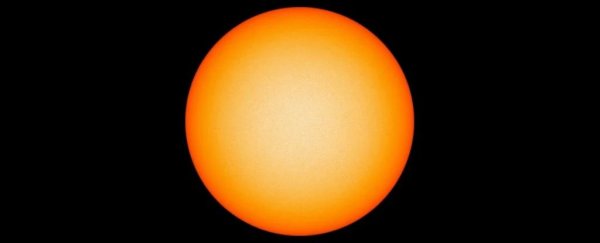On a long-enough scale, our Sun is rather predictable. Roughly every 11 years, it goes through a cycle of high and low activity, the former characterized by an uptick in sunspots, flares, and coronal mass ejections.
On a cycle-to-cycle basis, it can be hard to predict how much activity our Sun is going to go through; but there is always an increase to maximum sunspot activity, and a decrease back down to minimum.
Well, almost always. In the 17th century, the Sun went through a period in which almost no sunspots appeared at all. From 1645 to 1715, this period encompassed several solar cycles, and is known as the Maunder minimum.
This strange irregularity has long perplexed scientists; now, another nearby star could finally have the answer. It seems to have gone into a similar period of dormancy – and watching what it does could help us figure out what the heck our own Sun was up to.
"We don't really know what caused the Maunder minimum, and we have been looking to other sun-like stars to see if they can offer some insight," says physicist Anna Baum, formerly of Pennsylvania State University, now at Lehigh University.
"We have identified a star that we believe has entered a state similar to the Maunder minimum. It will be really exciting to continue to observe this star during, and hopefully as it comes out of, this minimum, which could be extremely informative about the Sun's activity 300 years ago."
The solar cycle is based on the Sun's magnetic field, generated by the action of a dynamo process in the stellar interior. Every 11 years during the solar maximum, the solar magnetic field flips, with its north and south magnetic poles switching places. Astronomers have been observing sunspots from about 1610, including by Galileo Galilei, and the first solar cycle on record started in 1755.
The solar minimum – characterized by a minimal level of sunspot and flare activity – occurs when the Sun's magnetic field is at its weakest.
This is because the Sun's magnetic field controls its activity: sunspots are temporary regions of strong magnetic fields, while coronal mass ejections and solar flares are produced by a release of energy when magnetic field lines tangle, snap and reconnect. So as the magnetic field strengthens, it stands to reason that there would be an increase in solar activity.
Other stars have been observed exhibiting spot activity too, although our records of these stars don't go nearly as far back in time. Baum and her colleagues collected data from multiple sources for several decades' worth of starspot activity for 59 stars.
Of these, 29 stars showed clear starspot cycles, similar to what we've seen in the Sun. Of the remainder, some showed no starspot activity at all, suggesting that they may be rotating too slow for dynamo processes, and for some, there was simply not enough data to make a ruling.
And, of those 29 stars, one was a standout: HD 166620, located 36 light-years away. This star is about 80 percent of the size and mass of the Sun, and around 6 billion years old (compared to the Sun's 4.6 billion years). It also seems to have an activity cycle of about 17 years, yet has shown absolutely no signs of sunspots since about 2003.
"When we first saw these data, we thought it must have been a mistake, that we pulled together data from two different stars or there was a typo in the catalog or the star was misidentified," said astrophysicist Jacob Luhn, formerly of Penn State, now at the University of California, Irvine.
"But we double- and triple-checked everything. The times of observation were consistent with the coordinates we expected the star to have. And there aren't that many bright stars in the sky that Mount Wilson observed. No matter how many times we checked, we always come to the conclusion that this star has simply stopped cycling."
This means it could also be experiencing a Maunder minimum. Vexingly, the start of this low activity period occurred during a gap between observations of the star; but continuing to observe the star throughout its low activity period could help shed light on our own Sun's weird activity.
"There's a big debate about what the Maunder minimum was," Baum said.
"Did the Sun's magnetic field basically turn off? Did it lose its dynamo? Or was it still cycling but at a very low level that didn't produce many sunspots? We can't go back in time to take measurements of what it was like, but if we can characterize the magnetic structure and magnetic field strength of this star, we might start to get some answers."
This, in turn, could help us get a better handle on solar weather, which has important implications for Earth and the rest of the Solar System. And it could help us better understand how stars work: what drives them, and what goes on in their mysterious hearts.
The research has been published in The Astronomical Journal.
